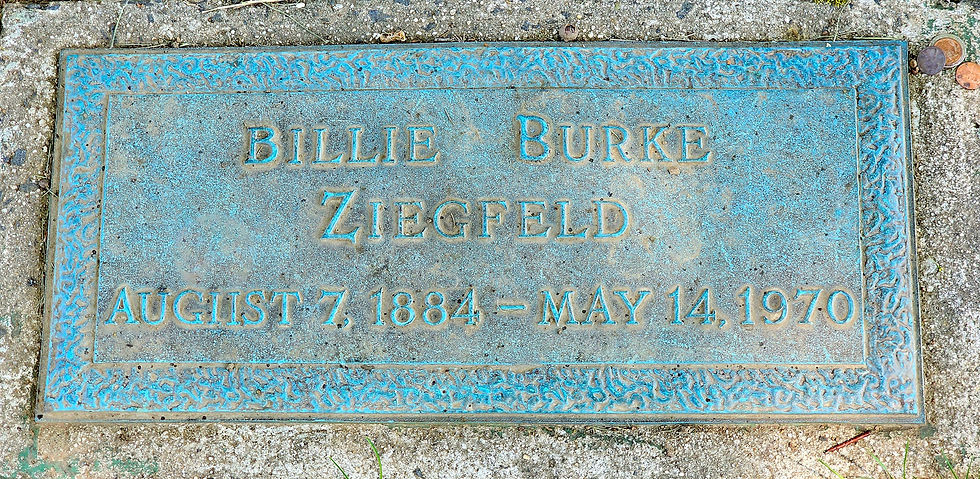The Woman Who Became Glinda
- Christine Shephard

- Sep 5
- 4 min read
Updated: Sep 11
Billie Burke was born as Mary William Ethelbert Appleton Burke on August 7, 1884, in Washington, D.C.

Her father, Billy Burke, was a famous circus clown with the Barnum and Bailey Circus, and she spent a significant part of her childhood traveling across Europe with him before the family finally settled in London.
In 1903, she was introduced to West End plays and began her acting career on the London stage, making her debut in "The School Girl." By 1906, she had earned critical acclaim and returned to the U.S. in 1907 to perform on Broadway, the world's theatrical hub. She became a celebrated figure on the great white way.
On New Year's Eve in 1914, the woman famous for her fiery red hair met Florenz Ziegfeld, Jr. at a party. He was the renowned Broadway producer of the dazzling Ziegfeld Follies, seventeen years older and notorious for his womanizing behavior.

Ziegfeld pursued her, lavishing her with presents. Despite numerous warnings, she wed Ziegfeld on April 11, 1914.
The marriage was not harmonious, mostly due to Ziegfeld's wandering eye, and Burke often threatened to leave.
In 1915, she was offered the lead role in the silent film "Peggy." Her transition from stage to film was remarkably successful, and some considered her a star on par with Mary Pickford or Lillian Gish.
Their only child, Patricia, was born in 1916.
Burke went on to make sixteen more films, all shot in New York. In 1921, she reduced her involvement in films to focus on raising Patricia and to return to the theater.
On Thursday, October 24, 1929, the stock market crashed and Ziegfeld lost all his wealth. Burke's immediate reaction was to find another play and get back to work. She had saved some money in her own name, which helped her pay off some of the debts of their lavish lifestyle.
Burke then moved to Los Angeles to embrace the era of "talkies" in cinema.
Her first project in this new stage of her career was George Cukor's 1932 drama "A Bill of Divorcement," where Katharine Hepburn made her movie debut.
Ziegfeld experienced a decline in theater ticket sales because people could no longer afford them after the depression hit. His later productions, "Bittersweet" and "Hot-Cha," did not succeed. However, his revival of "Show Boat" premiered on May 12, 1932, and became the biggest ticket on Broadway.
Regrettably, in July of that year, he was hospitalized in a New Mexico sanatorium because of persistent respiratory issues. After his discharge, he passed away a few days later from pleurisy, an inflammation of the lining of the lungs and chest wall.

Following Ziegfeld's death in 1932, Burke re-entered the film industry and appeared in another movie directed by Cukor, 1933's "Dinner at Eight". She played Millicent Jordan, a high-society woman making determined yet frequently scatterbrained attempts to manage a dinner party amid growing drama. The film was highly successful and marked Burke's return to the spotlight.
Starting in 1937, producer Hal Roach selected her to star in the comedic "Topper" film series (Topper (1937), Topper Takes a Trip (1938), and Topper Returns (1941). Each centered around the whimsical idea of a wealthy banker being visited by mischievous ghosts. Burke portrayed Clara Topper, Cosmo Topper's ambitious wife who was determined to always maintain a respectable appearance.

For most people who grew up watching television, she will always be remembered as Glinda, the Good Witch of the North in The Wizard of Oz (1939). Her performance was characterized by Glinda's gentle demeanor, glittering pink dress, and supportive, guiding advice to Dorothy. Burke's portrayal added a charming, ethereal touch to the character, who arrives in a pink bubble and delivers memorable lines like "Are you a good witch or a bad witch?" Although Burke had less screen time, her performance left a lasting impression, making her one of the film's most memorable characters.
During the 1940s, she continued her film career and later started a new series with the Vincente Minelli directed "Father of the Bride" (1950) and its sequel "Father's Little Dividend" (1951), alongside Spencer Tracy and Elizabeth Taylor, playing the role of Doris Dunston, the mother of the soon-to-be groom Buckley Dunston.
In 1952, she transitioned to television, but by 1953, her career began to decline. She completed just three more films before permanently retiring in Los Angeles, CA. She died of natural causes at the age of 85 in 1970.
Burke never remarried and was laid to rest beside her husband Florenz at Kensico Cemetery in Valhalla, NY. They are buried in the Powhatan Plot, close to the Remembrance Circle and the Garden of Serenity.

Christine Shephard is a photographer, writer, and avid taphophile. She makes her home in Central New York.
Images captured by Christine Shephard Photographic Design and the written content cannot be utilized in any other format or publication without express permission.
This article was written with information gathered from:
Billie Burke The History of Glinda
Glinda Enchanted Living Magazine
Wikipedia
Saturday Evening Post Missing in History Billie Burke's Tumultuous Relationship with Ziegfeld
Photos of Billie and Florenz Alchetron.com, Bettman Fine Art, Pinterest
Follow me by signing up for the Memento Mori mailing list.



Comments